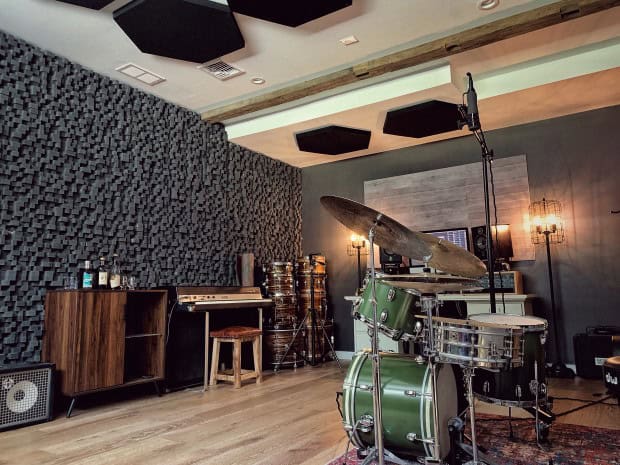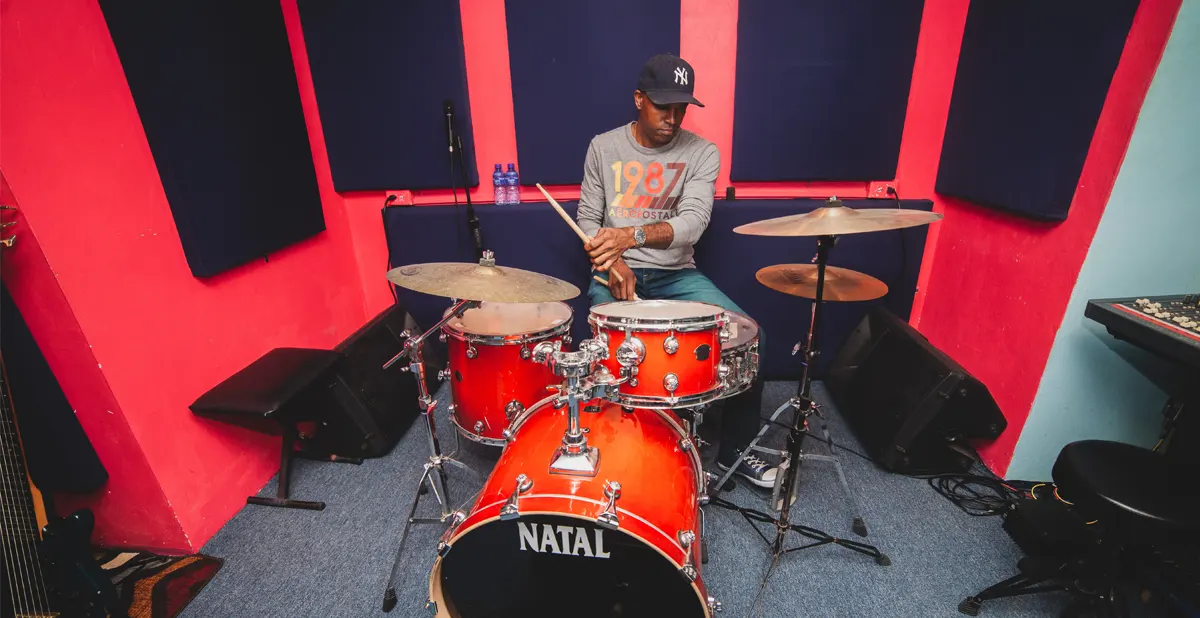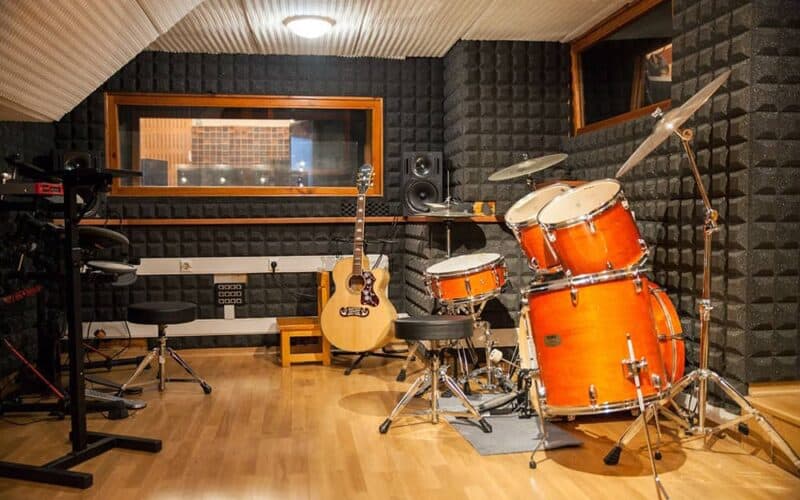DIY drum soundproofing involves using materials like heavy curtains, foam panels, rugs, and soundproofing mats to absorb and dampen sound, while also isolating the drum set from floors and walls to minimize noise transmission.
Soundproof Your Drums Like a Pro: Tips and Tricks for Quieter Practice Sessions
Drumming is an exhilarating and expressive form of musical expression. However, it can also be incredibly loud and disruptive, especially for those living in close proximity to your practice space. This is why soundproofing your drums is so important. Not only does it benefit those around you, but it also allows you to practice without any distractions or limitations.
The benefits of soundproofing your drums are numerous. Firstly, it helps to maintain good relationships with your neighbors or housemates. Excessive noise can be a major source of tension and conflict, and by soundproofing your drums, you can ensure that you are being considerate of those around you.
Secondly, soundproofing your drums allows you to practice for longer periods of time without worrying about disturbing others. This means that you can focus on honing your skills and improving as a drummer without any time constraints.
On the other hand, the negative effects of loud drumming can be significant. Prolonged exposure to loud noise can lead to hearing damage and loss, which can have long-term consequences for your overall health and well-being. Additionally, excessive noise can cause stress, anxiety, and sleep disturbances for both yourself and those around you.
Assess Your Practice Space: Identify the Noise Sources
Before you begin soundproofing your drums, it’s important to assess your practice space and identify the sources of noise. This will help you determine the most effective soundproofing solutions for your specific situation.
Start by understanding the sources of noise in your practice space. Is it primarily the drums themselves that are causing the noise, or are there other factors at play? For example, are the walls thin and allowing sound to easily pass through? Are there windows or doors that are not properly sealed? Identifying these sources will help you target your soundproofing efforts more effectively.
Once you have identified the sources of noise, it’s important to measure the noise level in your practice space. This will give you a baseline to work from and help you determine the effectiveness of your soundproofing efforts. There are various tools and apps available that can help you measure noise levels accurately.
Acoustic Treatment: The Key to Soundproofing Your Drums
Acoustic treatment is the key to soundproofing your drums effectively. It involves using materials and techniques to absorb, diffuse, or block sound waves, reducing the amount of noise that escapes from your practice space.
The importance of acoustic treatment cannot be overstated. Without proper treatment, sound waves will bounce off surfaces and reverberate throughout the room, creating a loud and chaotic environment. Acoustic treatment helps to control these reflections and create a more balanced and controlled sound.
When choosing acoustic treatment for your space, it’s important to consider the specific needs of your practice area. Different materials and techniques are more effective in different situations. For example, if you have a small practice room with hard surfaces, you may need to focus on absorbing sound waves with materials like foam panels or bass traps. On the other hand, if you have a larger space with high ceilings, diffusers may be more effective in controlling reflections.
Soundproofing Materials: What to Look for and Where to Find Them
There are a variety of soundproofing materials available on the market that can help you effectively soundproof your drums. These materials are designed to absorb, block, or diffuse sound waves, reducing the amount of noise that escapes from your practice space.
Some common types of soundproofing materials include foam panels, bass traps, acoustic curtains, and soundproofing blankets. Foam panels are often used to absorb high-frequency sounds, while bass traps are designed to absorb low-frequency sounds. Acoustic curtains and soundproofing blankets can be used to block sound and create a more controlled environment.
When choosing soundproofing materials, it’s important to consider factors such as the size of your practice space, the specific needs of your drum kit, and your budget. It’s also worth noting that not all soundproofing materials are created equal. Some may be more effective than others, so it’s important to do your research and choose materials that are specifically designed for soundproofing purposes.
DIY Soundproofing: Cost-Effective Solutions for Drummers on a Budget
If you’re on a budget, there are also plenty of cost-effective DIY solutions for soundproofing your drums. These solutions can be just as effective as commercial soundproofing materials, but at a fraction of the cost.
One popular DIY solution is to create your own soundproofing panels using materials like rockwool or fiberglass insulation. These materials can be easily cut to size and attached to the walls of your practice space using adhesive or nails. This helps to absorb sound waves and reduce the amount of noise that escapes from the room.
Another DIY solution is to use heavy curtains or blankets to block sound. These can be hung on walls or windows to create a barrier that prevents sound from escaping. Additionally, you can use weatherstripping or door sweeps to seal any gaps around doors or windows, further reducing the amount of noise that escapes.
Soundproofing Your Drum Kit: Tips and Tricks for Maximum Effectiveness
In addition to soundproofing your practice space, it’s also important to soundproof your drum kit itself. This will help to further reduce the amount of noise that escapes and create a more controlled and balanced sound.
One tip for soundproofing your drum kit is to use drum mutes or dampening pads. These are rubber or foam pads that can be placed on top of your drums or cymbals to reduce their volume. They are especially effective for reducing the volume of cymbals, which can be particularly loud and piercing.
Another tip is to use mesh drumheads instead of traditional drumheads. Mesh drumheads are made of a tightly woven fabric that helps to reduce the volume of your drums without sacrificing the feel or response. They are also more durable than traditional drumheads, making them a great investment for any drummer.
Soundproofing Your Room: Soundproofing Techniques for Walls, Floors, and Ceilings
In addition to soundproofing your drum kit, it’s also important to soundproof the walls, floors, and ceilings of your practice space. This will help to further reduce the amount of noise that escapes and create a more controlled and balanced sound.
One technique for soundproofing walls is to use acoustic panels or foam. These can be easily attached to the walls using adhesive or nails, helping to absorb sound waves and reduce reflections. Additionally, you can use double layers of drywall or add mass-loaded vinyl to the walls to create a barrier that blocks sound.
For soundproofing floors, you can use carpet or rugs to absorb sound and reduce vibrations. Additionally, you can use rubber underlayment or acoustic underlay to further reduce impact noise.
For soundproofing ceilings, you can use acoustic panels or foam to absorb sound waves and reduce reflections. Additionally, you can add mass-loaded vinyl or resilient channels to the ceiling to create a barrier that blocks sound.
Soundproofing Accessories: How to Enhance Your Soundproofing Efforts
In addition to soundproofing materials, there are also various accessories that can enhance your soundproofing efforts and further reduce the amount of noise that escapes from your practice space.
One accessory that can be particularly effective is a drum shield or drum booth. These are transparent barriers that surround your drum kit and help to contain the sound. They are especially useful for live performances or recording sessions where you need to control the sound more precisely.
Another accessory that can enhance your soundproofing efforts is a bass drum pillow or blanket. These are placed inside the bass drum to reduce the volume and control the resonance. They are particularly effective for reducing low-frequency vibrations that can be difficult to control.
Soundproofing Maintenance: Tips for Keeping Your Soundproofing Materials in Top Condition
Once you have soundproofed your drums and practice space, it’s important to maintain your soundproofing materials to ensure they remain effective over time.
One tip for maintaining your soundproofing materials is to regularly clean them. Dust and dirt can accumulate on the surface of the materials, reducing their effectiveness. Use a vacuum cleaner or a damp cloth to remove any debris and keep them clean.
Another tip is to regularly inspect your soundproofing materials for any signs of wear or damage. Over time, materials may become worn or lose their effectiveness. If you notice any tears, cracks, or other damage, it’s important to repair or replace them as soon as possible to maintain the integrity of your soundproofing efforts.
Noise-Canceling Headphones: An Alternative to Soundproofing Your Drums
If you’re unable to soundproof your drums or practice space, or if you’re looking for an alternative solution, noise-canceling headphones can be a great option. These headphones use advanced technology to actively cancel out external noise, allowing you to practice without any distractions.
The benefits of noise-canceling headphones are numerous. Firstly, they provide a high level of noise reduction, allowing you to practice at lower volumes without sacrificing the quality of the sound. This is especially useful if you live in an apartment or have neighbors who are sensitive to noise.
Secondly, noise-canceling headphones can help to protect your hearing. By reducing the amount of external noise that reaches your ears, they can help prevent hearing damage and loss that can occur from prolonged exposure to loud noise.
When choosing noise-canceling headphones for drumming, it’s important to consider factors such as sound quality, comfort, and durability. Look for headphones that have a high level of noise reduction, as well as a wide frequency response range to ensure that you can hear all the nuances of your drumming.
Enjoy Quieter Practice Sessions with These Soundproofing Tips and Tricks
In conclusion, soundproofing your drums is essential for maintaining good relationships with those around you and ensuring that you can practice without any distractions or limitations. By assessing your practice space, using acoustic treatment and soundproofing materials, and implementing DIY solutions, you can create a more controlled and balanced sound.
Remember to soundproof not only your practice space but also your drum kit itself. Use accessories to enhance your soundproofing efforts and regularly maintain your soundproofing materials to ensure their effectiveness over time.
If soundproofing is not an option, consider using noise-canceling headphones as an alternative solution. These headphones provide a high level of noise reduction and can help protect your hearing.
By following these tips and tricks, you can enjoy quieter practice sessions and focus on honing your skills as a drummer.
Originally posted 2024-02-29 06:53:26.



